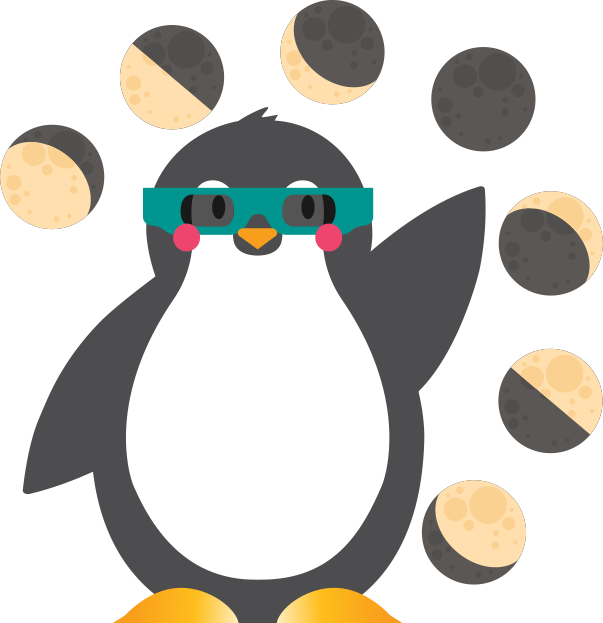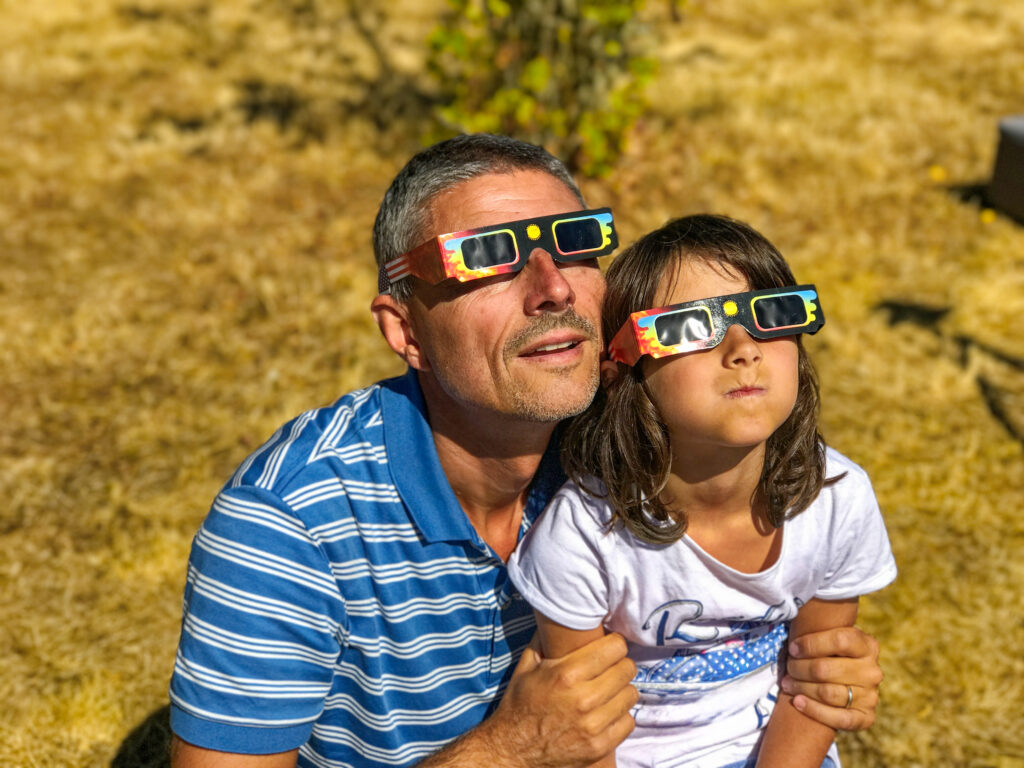
The upcoming total solar eclipse that will be visible along a narrow track stretching from Texas to Maine is a wonderful opportunity for your child care center to teach a science lesson while letting children experience a rare sight in the sky, as long as you take the right precautions to do so safely.
On April 8, this total solar eclipse will cross the United States and the sky will darken as if it were dawn or dusk. This type of eclipse happens when the moon passes between the sun and earth, completely blocking the face of the sun, according to NASA. A partial eclipse will be visible throughout all 48 contiguous U.S. states.
Plan eclipse viewing activities with children in advance so they are aware of the importance of safety precautions and can enjoy the experience.
Let’s look at some fun activities you can safely do with your young learners!
Proper Eyewear is Vital
Never look directly at the sun without proper eye protection, especially during an eclipse! You and the children in your care should wear special solar viewing glasses that meet the ISO 12312-2 international safety standard.
Ensure that children understand the dangers of using homemade filters or ordinary sunglasses, which do not provide adequate protection for viewing the sun. And supervise children at all times during the eclipse to make sure they are using their viewing glasses correctly and do not try to look at the sun directly.
NASA says that viewing any part of the bright sun through a camera lens, binoculars or a telescope without a special-purpose solar filter secured over the front of the optics will instantly cause severe eye injury.
You can view the eclipse directly without proper eye protection ONLY when the moon completely obscures the sun’s bright face during the brief and spectacular period known as totality, according to NASA. You’ll know it’s safe when you can no longer see any part of the sun through eclipse glasses or a solar viewer.
But as soon as you see even a little bit of the bright sun reappear after totality, make sure the children in your care put their eclipse glasses back on or use a handheld solar viewer to look at the sun.

Activities to Safely View the Eclipse
Make an Eclipse Projector
This is a project that your preschoolers might enjoy. Make an eclipse projector using a cardboard box, a white sheet of paper, tape, scissors and aluminum foil.
With the sun behind you and your students, sunlight will stream through a pinhole punched into aluminum foil taped over a hole in one side of the box.
During the partial phases of a solar eclipse, this will project a crescent sun onto a white sheet of paper taped to the inside of the box. Look into the box through another hole cut into the box to see the projected image.
Use Pinhole Projection
The American Astronomical Society shared the pinhole projection method for viewing the eclipse:
With the sun behind you, pass sunlight through a small opening (for example, a hole punched in an index card) and project a solar image onto a nearby surface such as another card, a wall or the ground. The society says a pasta colander makes a terrific pinhole projector, as does a straw hat or anything else with a bunch of small holes in it. But remember: do NOT look at the sun through the pinholes!
Cross the outstretched, slightly open fingers of one hand over the outstretched, slightly open fingers of the other with your palms facing up. Then, with your back to the sun, look at your hands’ shadow on the ground. The little spaces between your fingers will project a grid of small images on the ground. During the partial phases of a solar eclipse, these images will reveal the sun’s crescent shape.
If you have leafy trees near your child care center, look at the shadows of leaves on the ground. During a partial solar eclipse, which is what most of the country will see, the tiny spaces between the leaves will act as pinhole projectors, dappling the ground with images of the crescent sun.
Make a Mask from a Paper Plate to Wear Around Eclipse Glasses
NASA shared this hands-on activity using paper plates to provide additional coverage to children’s faces for safely viewing a solar eclipse by making it harder to look outside the lenses on the eclipse glasses.
Materials Required:
- ISO-approved solar eclipse viewing glasses (ISO requirements: 12312-2)
- Paper plates (medium or large)
- Scissors
- Clear tape
- Pencil, pen or marker
Teacher Preparation:
Teachers can prepare the plates for students or have students make them. It is essential that they are checked to make sure there are not gaps that sunlight can get through. The cardboard from the eclipse glasses should completely cover the cutouts in the plates.
- Inspect the ISO-approved solar eclipse viewing glasses to ensure that the lenses are not scratched or damaged.
- Select a paper plate size that will best fit the students.
- With the plate resting face up, place the eclipse glasses in the middle of the plate.
- Using a marking tool, trace the outline of the eclipse glasses.
- Mark the location of the lenses on the plate without touching the lenses on the eclipse glasses.
- Mark the edges where the eclipse glass arms connect.
- Cut sections out of the paper plate for the lenses and then cut slots in the plate for the arms of the eclipse glasses.
- Remove the lens cutouts.
- Insert the arms of the eclipse glasses through the slots to make sure that the lenses are lined up with the holes.
- Make sure that the outside edge of the glasses completely covers all cutout sections.
- Do not tape glasses to the plates if you are planning to decorate them.
Doing the Project With Children:
- Have students decorate the plates.
- Cut out a triangular section for the nose and mouth. A narrow triangle might work better for smaller children.
- Tape the glasses to the plate to secure them in place. Make sure that you tape the cardboard and not the lenses. If students do this, the teacher should check each pair of glasses to make sure they were taped properly and will provide the extra protection from paper plate.
- Check for proper fit.
- For younger children, the earpieces might not fit securely. In that case, a string, ribbon or rubber band can be attached to the sides of the plate so that the child can wear it like a mask. The string will help hold the protective shield in place.
Teach Science All Year With a Digital Curriculum Designed for ECE!

The eclipse is a great way to get kids excited about science. Keep children engaged by using a curriculum that includes lesson plans geared toward science throughout the year!
Procare Early Learning, in partnership with Learning Beyond Paper, is an all-digital curriculum specifically designed to meet the unique needs of educating children from infancy through pre-kindergarten. It’s an embedded, fully online curriculum program tailored to child care centers with a year-round program!
Active learning lessons are focused on science, technology, engineering, art and mathematics. This approach to learning guides students in inquiry, dialogue and critical thinking. Daily and weekly activities, teacher materials and at-home connection materials are all included.
The integration with Procare makes this curriculum program easy to use. New content, training and tools arrive automatically! It’s designed so teachers of all experience levels can understand it easily.
No more recording your assessments on paper. The built-in assessment tool helps teachers observe and plan for individual children right from within the Procare platform on their tablet or mobile device. Procare also enables the ability to create custom assessments.
It includes more than 4,000 daily activities for infants, younger toddlers, older toddlers, preschoolers and pre-kindergarteners.
Procare is the only solution that can deliver the entire early childhood education ecosystem — lesson planning, lesson delivery within the classroom as well as assessment and parent engagement. Being able to do all of these with one platform simplifies classroom management and planning!
How much time and money could your child care center save using a digital curriculum designed for young learners? Enter your number of staff, number of students and type of program into our online calculator to see your potential time and money savings!


